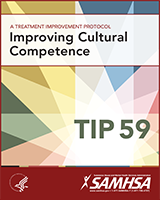The development of culturally responsive clinical skills is vital to the effectiveness of behavioral health services. According to the U.S. Department of Health and Human Services (HHS), cultural competence “refers to the ability to honor and respect the beliefs, languages, interpersonal styles, and behaviors of individuals and families receiving services, as well as staff members who are providing such services. Cultural competence is a dynamic, ongoing developmental process that requires a long-term commitment and is achieved over time” (HHS 2003a, p. 12). It has also been called “a set of behaviors, attitudes, and policies that . . . enable a system, agency, or group of professionals to work effectively in cross-cultural situations” (Cross et al. 1989, p. 13).
This Treatment Improvement Protocol (TIP) uses Sue’s (2001) multidimensional model for developing cultural competence. Adapted to address cultural competence across behavioral health settings, this model serves as a framework for targeting three organizational levels of treatment: individual counselor and staff, clinical and programmatic, and organizational and administrative. The chapters target specific racial, ethnic, and cultural considerations along with the core elements of cultural competence highlighted in the model. These core elements include cultural awareness, general cultural knowledge, cultural knowledge of behavioral health, and cultural skill development. The primary objective of this TIP is to assist readers in understanding the role of culture in the delivery of behavioral health services (both generally and with reference to specific cultural groups).







